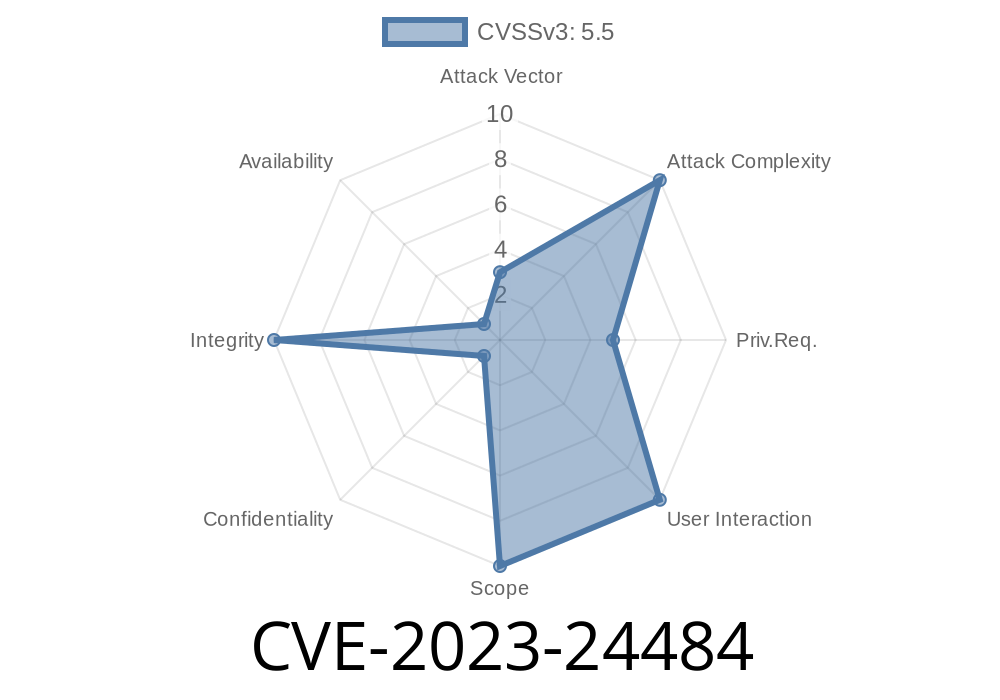In recent cybersecurity developments, a security vulnerability classified as CVE-2023-24484 has been discovered, which exposes a loophole for an attacker to maliciously write log files in unauthorized directories. The primary concern surrounding this issue is that attackers can manipulate systems by creating, modifying, or deleting important files in areas which they should not be allowed to access. In this post, we will dive deep into the exploit's specifics, code snippets to understand the vulnerability in detail, and provide links to the original sources and references.
Exploit Details
CVE-2023-24484 revolves around a misconfiguration in the permissions attached to certain directories or user accounts on a vulnerable system. Exploiting this vulnerability allows a malicious user to create log files or write log entries into existing files in areas where they ordinarily would not have any write access. This action can lead to unauthorized data manipulation, file corruption, or potentially opening additional avenues for compromise in the targeted system.
Assume the following code block represents a logging function for an application
void WriteToLog(string logMessage)
{
string logFilePath = "/var/log/myapp/";
// Check if log directory exists, if not create it
if (!Directory.Exists(logFilePath))
{
Directory.CreateDirectory(logFilePath);
}
// Write logMessage to log file
using (StreamWriter logWriter = new StreamWriter(logFilePath + "myapp.log", true))
{
logWriter.WriteLine(logMessage);
}
}
In the code above, the application attempts to create a log directory (/var/log/myapp/) if it does not already exist. The problem occurs when permissions aren't properly set, allowing attackers to replace the directory with a malicious link to another sensitive directory. This action causes log entries to be written to files that should be inaccessible to these users, resulting in this exploit.
Steps to Exploit
1. An attacker notices that the /var/log/myapp/ directory has weak or incorrect permissions, allowing unauthorized users to create or modify files.
2. They create a symbolic link to a restricted directory, e.g. /etc/protected_logs/, in place of the /var/log/myapp/.
3. When the vulnerable code is executed, log entries are now being written to a file in the /etc/protected_logs/ directory, which the attacker should not be allowed to access.
4. The attacker now has the ability to manipulate or corrupt the logging system, or potentially access sensitive information depending on the content of the log files being written.
Suggested Mitigation
Appropriate directory and file permissions should be enforced by system administrators, taking into consideration the Principle of Least Privilege. Developers should also write code that ensures proper permission checks when creating, modifying, or writing into files and directories.
Original References and Further Reading
1. CVE-2023-24484 Details
2. Understanding Symbolic Links
3. Secure File and Directory Permissions in Linux
In conclusion, CVE-2023-24484 is a perilous vulnerability that highlights the essential need for appropriate file and directory permission management on any system. System administrators and developers alike must work together to ensure that robust security practices are employed to prevent unauthorized manipulation and access throughout the infrastructure. Stay vigilant, keep systems up-to-date, and engage in continuous learning of cybersecurity best practices.
Timeline
Published on: 02/16/2023 18:15:00 UTC
Last modified on: 02/24/2023 19:28:00 UTC
